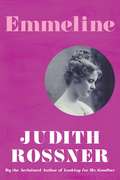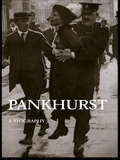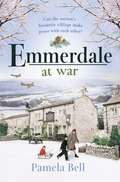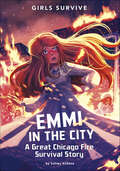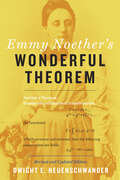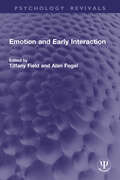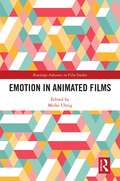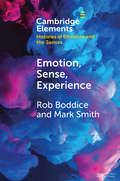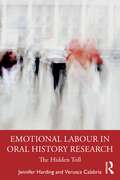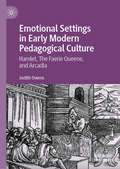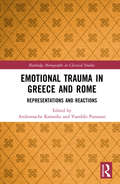- Table View
- List View
Emmanuel Levinas and the Politics of Non-Violence
by Victoria Tahmasebi-BirganiFrench philosopher and Talmudic commentator Emmanuel Levinas (1906-1995) has received considerable attention for his influence on philosophical and religious thought. In this book, Victoria Tahmasebi-Birgani provides the first examination of the applicability of Emmanuel Levinas' work to social and political movements. Investigating his ethics of responsibility and his critique of the Western liberal imagination, Tahmasebi-Birgani advances the moral, political, and philosophical debates on the radical implications of Levinas' work.Emmanuel Levinas and the Politics of Non-Violence is the first book to closely consider the affinity between Levinas' ethical vision and Mohandas Gandhi's radical yet non-violent political struggle. Situating Levinas' insights within a transnational, transcontinental, and global framework, Tahmasebi-Birgani highlights Levinas' continued relevance in an age in which violence is so often resorted to in the name of "justice" and "freedom."
Emmeline
by Judith RossnerFrom the New York Times bestselling author of Looking for Mr. Goodbar—a haunting tale of forbidden love set against the backdrop of the American industrial revolution.This is the story of Emmeline Mosher, who, before her fourteenth birthday, was sent from her home on a farm in Maine to support her family by working in a cotton mill in Massachusetts. So begins the sixth novel by the author of Looking for Mr. Goodbar. But nothing Judith Rossner has written can prepare the reader for this haunting love story of a young girl thrust into one of America’s early industrial towns, then drawn into a love affair for which she is far from ready. In Emmeline, Rossner brings us the intensity, grasp of character, and storytelling ability that have distinguished her novels of modern women.
Emmeline Pankhurst (Routledge Historical Biographies)
by Paula BartleyIn this well-structured, fluent and lively account, Paula Bartley uses new archival material to assess whether Pankhurst should be seen as a heroine or a tyrant, a conservative or a progressive. Emmeline Pankhurst was the most prominent campaigner for the women's right to vote and was transformed into a popular heroine of the early twentieth century. Early in life she was attracted to socialism, she grew into an entrenched and militant suffragette and ended up as a Conservative Party candidate. This new biography examines the guiding principles that underpinned all of Emmeline Pankhurst's actions, and places her achievements within a wider social and political context.
Emmeline Pankhurst: A Biography
by June PurvisEmmeline Pankhurst was perhaps the most influential woman of the twentieth century. Today her name is synonymous with the 'votes for women' campaign and she is remembered as the most brave and inspirational suffrage leader in history. In this absorbing account of her life both before and after the campaign for women's suffrage, June Purvis documents her early political work, her active role within the suffrage movement and her role as a wife and mother within her family.This fascinating full-length biography of Emmeline Pankhurst, the first for nearly seventy years, draws upon new approaches to feminist biography to place her within the context of her family and friends. It is based upon an unrivalled range of primary sources, including personal interviews with her surviving family.
Emmerdale at War: an uplifting and romantic read perfect for nights in (Emmerdale, Book 3)
by Pamela BellThe perfect Christmas gift full of warmth and nostalgia, for fans of ITV's Emmerdale, and readers who love heartwarming and heartbreaking stories set during World War II.Britain is at war once again and the families of Emmerdale are trying their best to cope with a new way of life.Rationing has been introduced across the country, two million more men have been called up for service, and blackouts, evacuees and military training camps have become the norm. In Beckindale, three young women are about to find their lives changed forever...Annie Pearson is working on Emmerdale Farm, while her love, Edward Sugden is at the front line. Lily Dingle has found purpose in joining the ATS, though she may get more than she bargained for. And Meg Warcup, now teaching at the local school, has taken in two children evacuated from Hull. They've adjusted to their new way of life until one day a German plane comes crashing down in the village... and changes everything in the village of Beckindale.The third novel in the Emmerdale series transports us to the Yorkshire Dales in the midst of World War II, exploring the lives of Emmerdale's much-loved families. Will the nation's favourite village overcome adversity to deal with the loves and lives lost?
Emmerdale at War: an uplifting and romantic read perfect for nights in (Emmerdale, Book 3) (Emmerdale)
by Pamela BellThe perfect Christmas gift full of warmth and nostalgia, for fans of ITV's Emmerdale, and readers who love heartwarming and heartbreaking stories set during World War II.Britain is at war once again and the families of Emmerdale are trying their best to cope with a new way of life.Rationing has been introduced across the country, two million more men have been called up for service, and blackouts, evacuees and military training camps have become the norm. In Beckindale, three young women are about to find their lives changed forever...Annie Pearson is working on Emmerdale Farm, while her love, Edward Sugden is at the front line. Lily Dingle has found purpose in joining the ATS, though she may get more than she bargained for. And Meg Warcup, now teaching at the local school, has taken in two children evacuated from Hull. They've adjusted to their new way of life until one day a German plane comes crashing down in the village... and changes everything in the village of Beckindale.The third novel in the Emmerdale series transports us to the Yorkshire Dales in the midst of World War II, exploring the lives of Emmerdale's much-loved families. Will the nation's favourite village overcome adversity to deal with the loves and lives lost?
Emmett Till: The Murder That Shocked the World and Propelled the Civil Rights Movement (Race, Rhetoric, and Media Series)
by Devery S. AndersonEmmett Till: The Murder That Shocked the World and Propelled the Civil Rights Movement offers the first, and as of 2018, only comprehensive account of the 1955 murder, the trial, and the 2004-2007 FBI investigation into the case and Mississippi grand jury decision. By all accounts, it is the definitive account of the case. It tells the story of Emmett Till, the fourteen-year-old African American boy from Chicago brutally lynched for a harmless flirtation at a country store in the Mississippi Delta. Anderson utilizes documents that had never been available to previous researchers, such as the trial transcript, long-hidden depositions by key players in the case, and interviews given by Carolyn Bryant to the FBI in 2004 (her first in fifty years), as well as other recently revealed FBI documents. Anderson also interviewed family members of the accused killers, most of whom agreed to talk for the first time, as well as several journalists who covered the murder trial in 1955. Till's murder and the acquittal of his killers by an all-white jury set off a firestorm of protests that reverberated all over the world and spurred on the civil rights movement. Like no other event in modern history, the death of Emmett Till provoked people all over the United States to seek social change. Anderson's exhaustively researched book was also the basis for the ABC miniseries Women of the Movement, which was written/executive-produced by Marissa Jo Cerar; directed by Gina Prince-Bythewood, Tina Mabry, Julie Dash, and Kasi Lemmons; and executive-produced by Jay-Z, Jay Brown, Tyran “Ty Ty” Smith, Will Smith, James Lassiter, Aaron Kaplan, Dana Honor, Michael Lohmann, Rosanna Grace, Alex Foster, John Powers Middleton, and David Clark. For over six decades the Till story has continued to haunt the South as the lingering injustice of Till's murder and the aftermath altered many lives. Fifty years after the murder, renewed interest in the case led the Justice Department to open an investigation into identifying and possibly prosecuting accomplices of the two men originally tried. Between 2004 and 2005, the Federal Bureau of Investigation conducted the first real probe into the killing and turned up important information that had been lost for decades. Anderson covers the events that led up to this probe in great detail, as well as the investigation itself. This book will stand as the definitive work on Emmett Till for years to come. Incorporating much new information, the book demonstrates how the Emmett Till murder exemplifies the Jim Crow South at its nadir. The author accessed a wealth of new evidence. Anderson made a dozen trips to Mississippi and Chicago over a ten-year period to conduct research and interview witnesses and reporters who covered the trial. In Emmett Till, Anderson corrects the historical record and presents this critical saga in its entirety.
Emmett and Gem County
by Gem County Historical Society Julianne Rekow PetersonThe Payette River and some of its tributaries serve Gem County from border to border. An abundance of water, a mild climate with protected valley floors, and natural vegetation beckoned to those on Placerville's Umatilla Trail. Having reached the ocean, many of those who had not found their utopia were on the move again, looking with an experienced eye for a place to settle with their families. These valleys had blessed the Shoshoni Indians, as well as the fur trappers and enterprising people providing services to early travelers. As communities progressed, the timber industry, railroads, highways, agriculture, horticulture, and ranching matured to meet demand. This growth, with only occasional setbacks, is documented by this collection of photographs.
Emmi in the City: A Great Chicago Fire Survival Story (Girls Survive Ser.)
by Salima AlikhanAlthough Emmi has lived in Chicago for two years, she finds it hard to love her adopted city. As a German immigrant in the early 1870s, she's often teased by her American-born peers. But when the Great Fire breaks out on October 8, 1871, Emmi and her enemies find themselves braving the smoke and flames together.
Emmi in the City: A Great Chicago Fire Survival Story (Girls Survive)
by Salima AlikhanAlthough Emmi has lived in Chicago for two years, she finds it hard to love her adopted city. As a German immigrant in the early 1870s, she's often teased by her America-born peers. But when the Great Fire breaks out on October 8, 1871, Emmi and her enemies find themselves braving the smoke and flames together. Can Emmi and the others survive the danger to escape the burning city? Readers can learn the real story of the Great Chicago Fire from the nonfiction back matter in this Girls Survive story. A glossary, discussion questions, and writing prompts are also provided.
Emmy Noether's Wonderful Theorem
by Dwight E. NeuenschwanderOne of the most important—and beautiful—mathematical solutions ever devised, Noether’s theorem touches on every aspect of physics."In the judgment of the most competent living mathematicians, Fräulein Noether was the most significant creative mathematical genius thus far produced since the higher education of women began."—Albert EinsteinThe year was 1915, and the young mathematician Emmy Noether had just settled into Göttingen University when Albert Einstein visited to lecture on his nearly finished general theory of relativity. Two leading mathematicians of the day, David Hilbert and Felix Klein, dug into the new theory with gusto, but had difficulty reconciling it with what was known about the conservation of energy. Knowing of her expertise in invariance theory, they requested Noether’s help. To solve the problem, she developed a novel theorem, applicable across all of physics, which relates conservation laws to continuous symmetries—one of the most important pieces of mathematical reasoning ever developed.Noether’s "first" and "second" theorem was published in 1918. The first theorem relates symmetries under global spacetime transformations to the conservation of energy and momentum, and symmetry under global gauge transformations to charge conservation. In continuum mechanics and field theories, these conservation laws are expressed as equations of continuity. The second theorem, an extension of the first, allows transformations with local gauge invariance, and the equations of continuity acquire the covariant derivative characteristic of coupled matter-field systems. General relativity, it turns out, exhibits local gauge invariance. Noether’s theorem also laid the foundation for later generations to apply local gauge invariance to theories of elementary particle interactions. In Dwight E. Neuenschwander’s new edition of Emmy Noether’s Wonderful Theorem, readers will encounter an updated explanation of Noether’s "first" theorem. The discussion of local gauge invariance has been expanded into a detailed presentation of the motivation, proof, and applications of the "second" theorem, including Noether’s resolution of concerns about general relativity. Other refinements in the new edition include an enlarged biography of Emmy Noether’s life and work, parallels drawn between the present approach and Noether’s original 1918 paper, and a summary of the logic behind Noether’s theorem.
Emotion and Early Interaction (Psychology Revivals)
by Alan Fogel Tiffany FieldOriginally published in 1982, Emotion and Early Interaction is a collection of papers by investigators who had been attempting to integrate emotion and interaction processes in early development. None professed to have all the answers, yet each paper challenges us to question some of our notions about the boundaries between the individual and society. The first part includes chapters on the face-to-face interaction of infants and others during early infancy. These early interactions had become miniature natural laboratories in which many investigators found a wealth of opportunities to study infant emotions and their development. The second part covers play interactions in older infants and toddlers. Here the methods and concepts are different due to the increasing complexity of the infant’s behavior, and the increasing use of linguistic, in addition to non-verbal expressions of emotion. The final part on methodology covers a wide range of issues in the study of early interactions. Today it can be read in its historical context.
Emotion in Animated Films (Routledge Advances in Film Studies)
by Meike UhrigRanging from blockbuster movies to experimental shorts or documentaries to scientific research, computer animation shapes a great part of media communication processes today. Be it the portrayal of emotional characters in moving films or the creation of controllable emotional stimuli in scientific contexts, computer animation’s characteristic artificiality makes it ideal for various areas connected to the emotional: with the ability to move beyond the constraints of the empirical "real world," animation allows for an immense freedom. This book looks at international film productions using animation techniques to display and/or to elicit emotions, with a special attention to the aesthetics, characters and stories of these films, and to the challenges and benefits of using computer techniques for these purposes.
Emotion in Christian and Islamic Contemplative Texts, 1100–1250: Cry of the Turtledove (The New Middle Ages)
by A. S. LazikaniThis book offers a comparative study of emotion in Arabic Islamic and English Christian contemplative texts, c. 1110-1250, contributing to the emerging interest in ‘globalization’ in medieval studies. A.S.Lazikani argues for the necessity of placing medieval English devotional texts in a more global context and seeks to modify influential narratives on the ‘history of emotions’ to enable this more wide-ranging critical outlook. Across eight chapters, the book examines the dialogic encounters generated by comparative readings of Muhyddin Ibn ‘Arabi (1165-1240), ‘Umar Ibn al-Fārid (1181-1235), Abu al-Hasan al-Shushtarī (d. 1269), Ancrene Wisse (c. 1225), and the Wooing Group (c. 1225). Investigating the two-fold ‘paradigms of love’ in the figure of Jesus and in the image of the heart, the (dis)embodied language of affect, and the affective semiotics of absence and secrecy, Lazikani demonstrates an interconnection between the religious traditions of early Christianity and Islam.
Emotion, Ritual and Power in Europe, 1200–1920: Family, State and Church (Palgrave Studies in the History of Emotions)
by Katie Barclay Merridee L. BaileyThis volume spans the fourteenth to nineteenth centuries, across Europe and its empires, and brings together historians, art historians, literary scholars and anthropologists to rethink medieval and early modern ritual. The study of rituals, when it is alert to the emotions which are woven into and through ritual activities, presents an opportunity to explore profoundly important questions about people’s relationships with others, their relationships with the divine, with power dynamics and importantly, with their concept of their own identity. Each chapter in this volume showcases the different approaches, theories and methodologies that can be used to explore emotions in historical rituals, but they all share the goal of answering the question of how emotions act within ritual to inform balances of power in its many and varied forms. Chapter 5 of this book is available open access under a CC BY 4.0 license.
Emotion, Sense, Experience (Elements in Histories of Emotions and the Senses)
by Mark Smith Rob BoddiceEmotion, Sense, Experience calls on historians of emotions and the senses to come together in serious and sustained dialogue. The Element outlines the deep if largely unacknowledged genealogy of historical writing insisting on a braided history of emotions and the senses; explains why recent historical treatments have sometimes profitably but nonetheless unhelpfully segregated the emotions from the senses; and makes a compelling case for the heuristic and interpretive dividends of bringing emotions and sensory history into conversation. Ultimately, we envisage a new way of understanding historical lived experience generally, as a mutable product of a situated world-brain-body dynamic. Such a project necessarily points us towards new interdisciplinary engagement and collaboration, especially with social neuroscience. Unpicking some commonly held assumptions about affective and sensory experience, we re-imagine the human being as both biocultural and historical, reclaiming the analysis of human experience from biology and psychology and seeking new collaborative efforts.
Emotional Alterity in the Medieval North Sea World (Palgrave Studies in the History of Emotions)
by Daniel Anlezark Erin Sebo Matthew FirthThis book addresses a little-considered aspect of the study of the history of emotions in medieval literature: the depiction of perplexing emotional reactions. Medieval literature often confronts audiences with displays of emotion that are improbable, physiologically impossible, or simply unfathomable in modern social contexts. The intent of such episodes is not always clear; medieval texts rarely explain emotional responses or their motivations. The implication is that the meanings communicated by such emotional display were so obvious to their intended audience that no explanation was required. This raises the question of whether such meanings can be recovered. This is the task to which the contributors to this book have put themselves. In approaching this question, this book does not set out to be a collection of literary studies that treat portrayals of emotion as simple tropes or motifs, isolated within their corpora. Rather, it seeks to uncover how such manifestations of feeling may reflect cultural and social dynamics underlying vernacular literatures from across the medieval North Sea world.
Emotional Bodies: The Historical Performativity of Emotions (The History of Emotions)
by Dolores Martín-Moruno Beatriz PichelWhat do emotions actually do? Recent work in the history of emotions and its intersections with cultural studies and new materialism has produced groundbreaking revelations around this fundamental question. In Emotional Bodies, contributors pick up these threads of inquiry to propose a much-needed theoretical framework for further studying the materiality of emotions, with an emphasis on emotions' performative nature. Drawing on diverse sources and wide-ranging theoretical approaches, they illuminate how various persons and groups—patients, criminals, medieval religious communities, revolutionary crowds, and humanitarian agencies—perform emotional practices. A section devoted to medical history examines individual bodies while a section of social and political histories studies the emergence of collective bodies. Contributors: Jon Arrizabalaga, Rob Boddice, Leticia Fernández Fontecha, Emma Hutchison, Dolores Martín Moruno, Piroska Nagy, Beatriz Pichel, María Rosón, Pilar León Sanz, Bertrand Taithe, and Gian Marco Vidor.
Emotional Diplomacy: Official Emotion on the International Stage
by Todd H. HallIn Emotional Diplomacy, Todd H. Hall explores the politics of officially expressed emotion on the international stage, looking at the ways in which state actors strategically deploy emotional behavior to shape the perceptions of others. Examining diverse instances of emotional behavior, Hall reveals that official emotional displays are not simply cheap talk but rather play an important role in the strategies and interactions of state actors. Emotional diplomacy is more than rhetoric; as this book demonstrates, its implications extend to the provision of economic and military aid, great-power cooperation, and even the use of armed force. Emotional Diplomacy provides the theoretical tools necessary for understanding the nature and significance of state-level emotional behavior and offers new observations of how states seek reconciliation, strategically respond to unforeseen crises, and demonstrate resolve in the face of perceived provocations. Hall investigates three specific strands of emotional diplomacy: those rooted in anger, sympathy, and guilt. Presenting original research drawing on sources and interviews in five different languages, Hall provides new insights into the 1995–1996 Taiwan Strait Crisis, the post-9/11 reactions of China and Russia, and relations between West Germany and Israel after World War II. He also demonstrates how his arguments can be extended to further cases ranging from Sino-Japanese relations to diplomatic interactions in Latin America. Emotional Diplomacy offers a unique take on the intersection of strategic action and emotional display, offering a means for making sense of why states appear to behave emotionally.
Emotional Experience and Microhistory: A Life Story of a Destitute Pauper Poet in the 19th Century (Microhistories)
by Sigurður Gylfi MagnússonEmotional Experience and Microhistory explores the life and death of Magnús Hj. Magnússon through his diary, poetry and other writing, showing how best to use the methods of microhistory to address complicated historical situations. The book deals with the many faces of microhistory and applies it’s methodology to the life of the Icelandic destitute pauper poet Magnús Hj. Magnússon (1892–1916). Having left his foster home at the age of 19 in 1892, he lived a peripatetic existence in an unstinting struggle with poor health, together with a ceaseless quest for a space to pursue writing and scholarship in accord with his dreams. He produced and accumulated a huge quantity of sources (autobiography, diary, poems, reflections) which are termed by the author as ‘egodocuments’. The book demonstrates how these egodocuments can be applied systematically, revealing unexpected perspectives on his life and demonstrating how integration of diverse sources can open up new perspectives on complex and difficult subjects. In so doing, the author offers an understanding both of how Magnússon’s story has been told, and how it can give insight into such matters as gender relations and sexual life, and the history of emotions. Highlighting how the historiographical development of modern scholarship has shaped scholars’ ideas about egodocuments and microhistory around the world, the book is of great use and interest to scholars of microhistory, social and cultural modern history, literary theory, anthropology and ethnology.
Emotional Labour in Oral History Research: The Hidden Toll
by Jennifer Harding Verusca CalabriaEmotional Labour in Oral History Research critically appraises the many complex ways in which emotion management features in oral history research and its specific implications for the researcher.Uniquely, this volume draws on oral historians’ personal accounts of conducting sensitive research and assesses the applicability of the term emotional labour to this work. It examines how oral historians may perform emotional labour, highlighting the often-hidden emotional toll it takes on them. This volume considers how the emotionally taxing implications of conducting sensitive research may be exacerbated or mitigated by the institutional relations and contexts in which the researcher works. The authors evaluate recommendations from related disciplinary fields for ways of supporting researchers and consider how an ethics of care can be fostered in local research environments. Emotional Labour in Oral History Research engages critically with theories of emotion, conceptualisations of emotional labour, questions of power and positionality, an ethics of care and debate on the impact of neoliberal ideas and policies on the higher education sector.This book will be of interest to all those using oral history to conduct sensitive research in all locations and at all career stages, including doctoral students, academics new to oral history, established oral historians, community-based oral historians and qualitative researchers in adjacent disciplines.
Emotional Landscapes: Love, Gender, and Migration (Studies of World Migrations #27)
by Donna R. Gabaccia Alexander Freund Marcelo J. Borges Elizabeth Zanoni A. James Hammerton Linda Reeder Sonia Cancian María Bjerg Tyler Carrington Margarita Dounia Mirjam Milharèiè Hladnik Emily Pope-Obeda Roberta Ricucci Suzanne M SinkeLove and its attendant emotions not only spur migration—they forge our response to the people who leave their homes in search of new lives. Emotional Landscapes looks at the power of love, and the words we use to express it, to explore the immigration experience. The authors focus on intimate emotional language and how languages of love shape the ways human beings migrate but also create meaning for migrants, their families, and their societies. Looking at sources ranging from letters of Portuguese immigrants in the 1880s to tweets passed among immigrant families in today's Italy, the essays explore the sentimental, sexual, and political meanings of love. The authors also look at how immigrants and those around them use love to justify separation and loss, and how love influences us to privilege certain immigrants—wives, children, lovers, refugees—over others. Affecting and perceptive, Emotional Landscapes moves from war and transnational families to gender and citizenship to explore the crossroads of migration and the history of emotion. Contributors: María Bjerg, Marcelo J. Borges, Sonia Cancian, Tyler Carrington, Margarita Dounia, Alexander Freund, Donna R. Gabaccia, A. James Hammerton, Mirjam Milharčič Hladnik, Emily Pope-Obeda, Linda Reeder, Roberta Ricucci, Suzanne M. Sinke, and Elizabeth Zanoni
Emotional Motives in International Relations: Rage, Rancour and Revenge (Routledge Research in International Relations Theory)
by Rupert BrodersenThe study of emotions in International Relations is gaining wide-spread attention. Within the "emotional turn" in IR the emotion of rage however has not been given sufficient attention, instead being used as short-hand for irrationality and excess. Rage is arguably one of the oldest and most destructive emotions in human affairs. This book offers an innovative approach that seeks to split rage into its traditional manifestation of aggression and violence, and into a less visible, passive manifestation of Nietzschean Ressentiment. This model facilitates a comprehensive understanding of revisionist motivation, from the violence of ISIS to the oppositionism of Putin’s Russia. The aim is to illustrate how a lack of violence can belie vengeful impulses and a silent rage, and how acts of violence, regardless of brutality, are often framed as a type of justice and "moral imperative" in the mind of the aggressor. This book raises serious questions and concerns about legitimacy and order in global affairs, and offers a firm theoretical basis for the exploration of present day conflicts.
Emotional Settings in Early Modern Pedagogical Culture: Hamlet, The Faerie Queene, and Arcadia
by Judith OwensThis book is notable for bringing together humanist schooling and familial instruction under the banner of emotions and for studying seminal works of early modern literature within this new analytical context. It thus furnishes unique ways to think about two closely interrelated moral imperatives: shaping boys into civil subjects; and fashioning heroic agency and selfhood in literature. In tracing the emotional dynamics of the humanist classroom, this book shows just how thoroughly school could accommodate resistance to authority and foster unruly boys. In gauging the emotional pressures at work in filial relationships, it shows how profoundly sons could experience patriarchal authority as provisional, negotiable, or damaging. In turning to Shakespeare’s Hamlet, Spenser’s Prince Arthur, and Sidney’s Arcadian heroes, Emotional Settings highlights the ways in which the respective emotional and moral imperatives of home and school could bring conflicting pressures to bear in the formation of heroic agency – and at what cost. Engaging and accessible, this book will appeal to scholars interested in early modern literature, pedagogy, histories of emotion, and histories of the family, as well as to graduate students and advanced undergraduate students in these fields.
Emotional Trauma in Greece and Rome: Representations and Reactions (Routledge Monographs in Classical Studies)
by Vassiliki Panoussi Andromache KaranikaThis volume examines emotional trauma in the ancient world, focusing on literary texts from different genres (epic, theatre, lyric poetry, philosophy, historiography) and archaeological evidence. The material covered spans geographically from Greece and Rome to Judaea, with a chronological range from about 8th c. bce to 1st c. ce. The collection is organized according to broad themes to showcase the wide range of possibilities that trauma theory offers as a theoretical framework for a new analysis of ancient sources. It also demonstrates the various ways in which ancient texts illuminate contemporary problems and debates in trauma studies.

